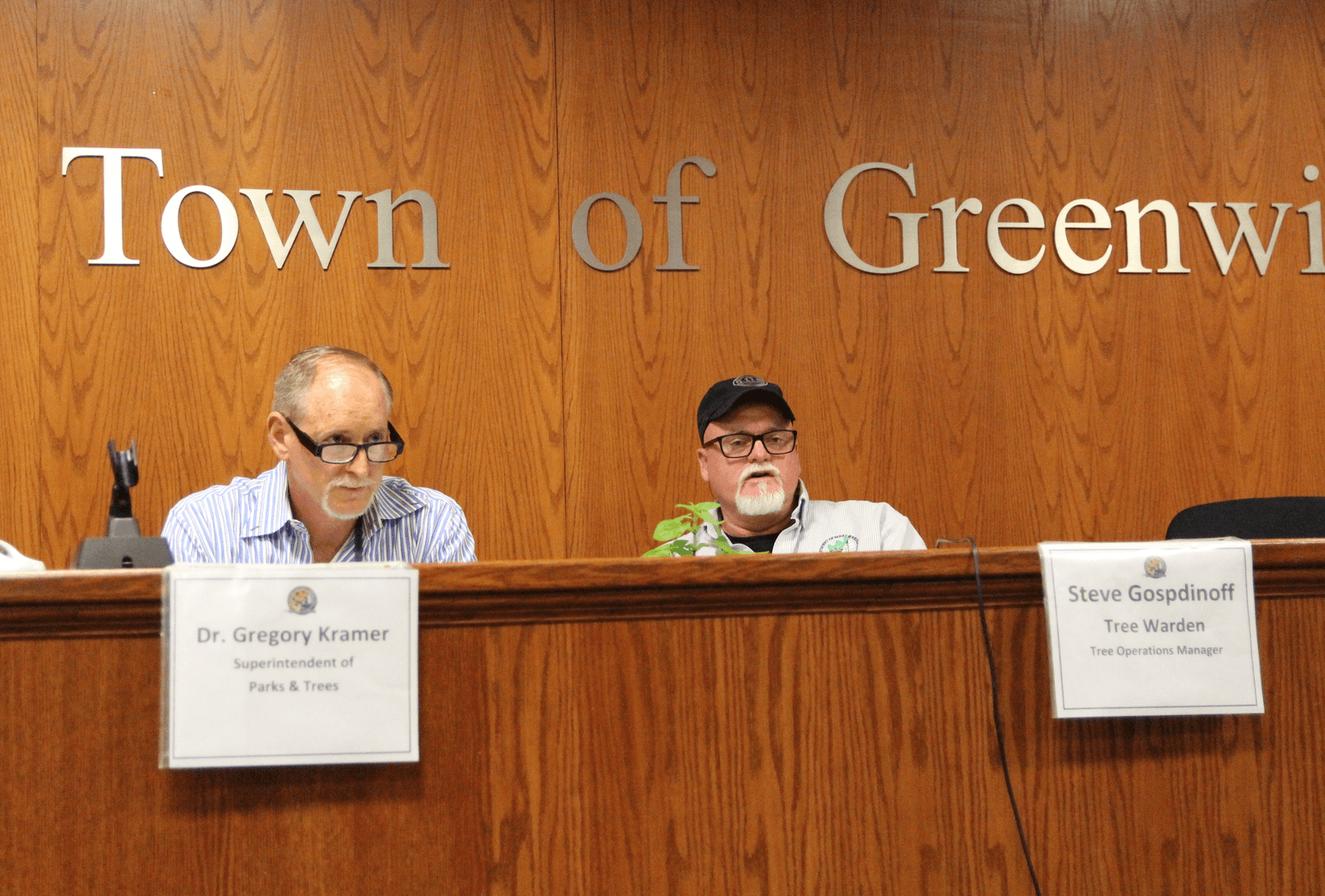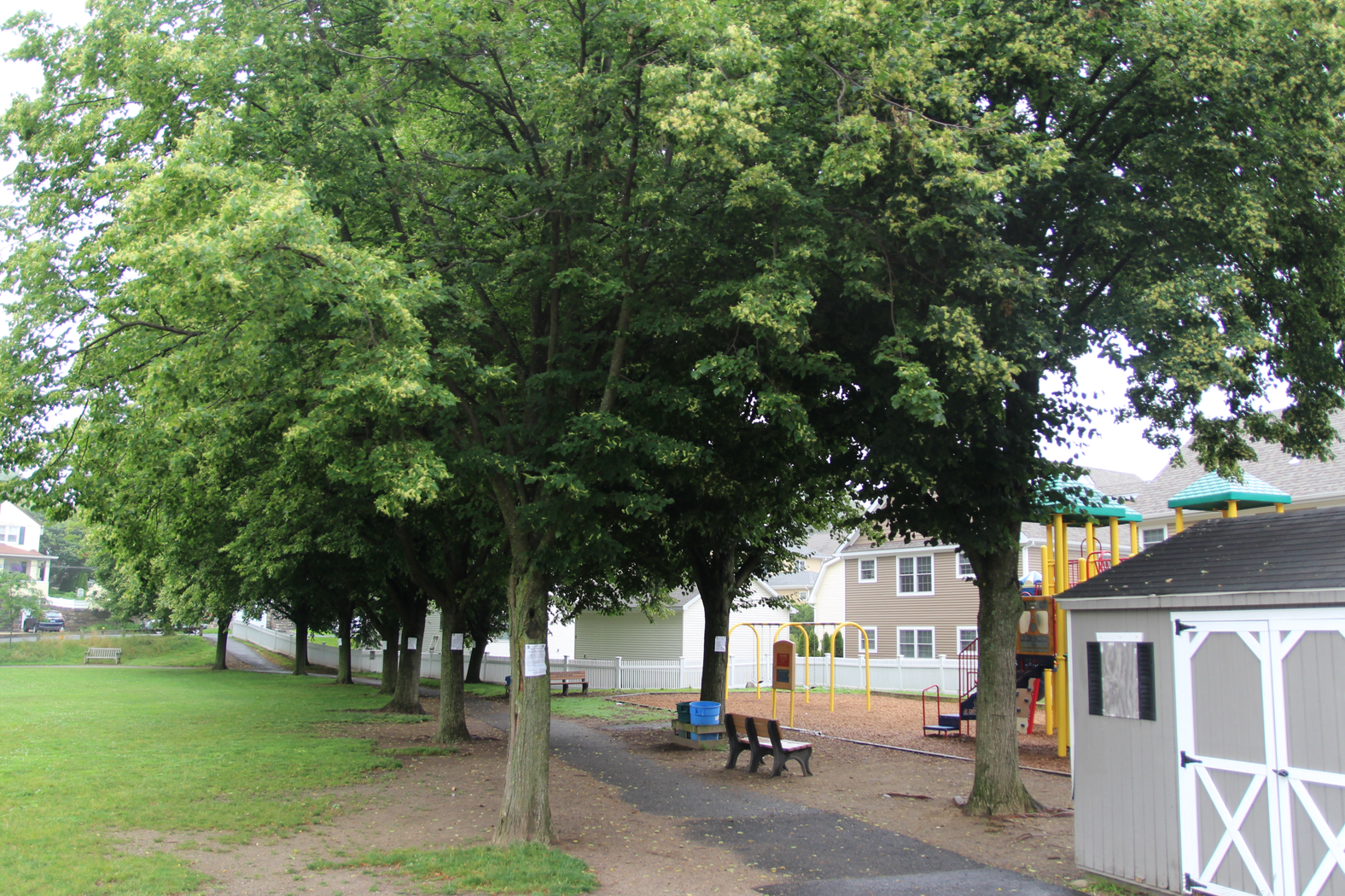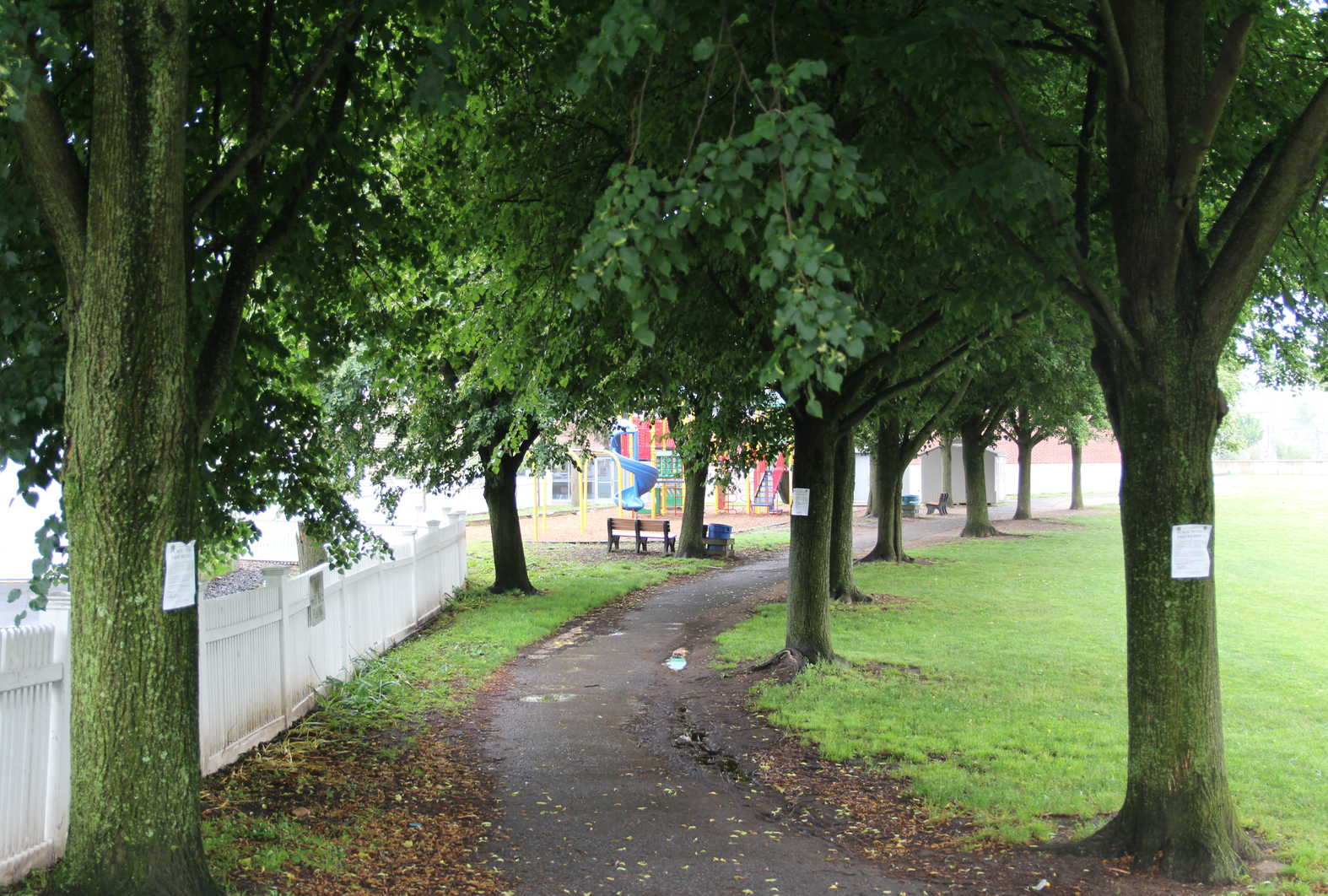Back on June 28, 19 trees were posted for removal on the property of Hamilton Avenue School per request of the Board of Education, who have received complaints for years that the field is not level, is rocky, and marked by divots.
Complaints about the tree postings were abundant, which triggered Tuesday’s public hearing in the Town Hall meeting room.
Considering it was the middle of summer and on a weekday, the turnout was significant and the comments were passionate.
Greenwich Tree Warden Steve Gospodinoff listed the type and diameter of each of the 19 trees that were posted.
The ones that residents spoke most passionately about were the Linden trees that Gospodinoff estimated to have been planted in the 1960s.

Dr. Gregory Kramer, Superinendent of Parks & Trees, and Tree Warden Steve Gospodinoff. July 16, 2019 Photo: Leslie Yager
Chickahominy neighbors, one after the other, urged the tree warden to come up with a compromise that would spare the trees, pointing out that they provide wildlife habitat, as well as shade, not only for the children who play on the playground but also for the community.
Mr. Gospodinoff read loud lead about a dozen passionate letters objecting to the removal of the trees.
Before the mic was opened for public comments, Facilities Director for Greenwich Schools Dan Watson reviewed the history of the project.
Watson, who has been with the district for 22 months said the project was brought to his attention on his first day.
“Hamilton Avenue School was rebuilt about 10 years ago, and as a result of that project and the addition of the parking garage and underground geothermal wells, the field was raised, which created a sloping effect. The incline is between 5% and 6%,” he explained
Watson said the situation was unfortunate.
“It was brought to our attention that the field is not the way they anticipated it after the project. We looked at documentation… There was no specification about how that field was supposed to be left,” he said.
“We have been asked to bring the field back to a more level condition, and to do that we have to add fill from the northern end….By bringing in the fill, you’d cover up the base of the trees which would suffocate the trees. We always anticipated the replacement of the trees,” he added.
Watson said that throughout the process to obtain funds to improve the field, “The removal of the trees in question was part of the proposal, and was approved by BOE and during the BET process.”
Yet neighbor after neighbor, and parent after parent all said they were taken unawares and objected to removal of the trees.
One resident, Laura Ryan who resides on Edgewood, asked why the field needed to be perfectly flat.
“There’s got to be options. I’m tired of seeing the school be a test project for the Town. It’s for the children, but it’s also for the community. The school was supposed to include a community room, but that was taken out,” Ms. Ryan said. “This should be inclusive of the community.”
Donald Mohr from Parks & Rec talked about field use. He acknowledged that the field slopes upward and does not give as much flexibility as other fields.
“If it was level, it would add to the overall field inventory, which is small due to fields closed for remediation and turf that need replacement,” he said. But, he said, “I don’t think the removal of the trees would increase the footprint of field.”
Mr. Mohr elaborated on the limitations of the field.
“A flatter surface would give us more flexibility, but not a lot more space for playing fields than we have now,” he added. “If we eliminate the baseball diamond and put in a small soccer field, that might work. …. It could be used for flag football practice and informal soccer practice. A bigger baseball diamond could be used for t-ball for kids age 7-9, but you’re not going to have older kids playing baseball there. That’s probably why there is the sign saying ‘no hardball.'”
Parks & Rec director Joe Siciliano said the plan was missing details.
“Can we see some of the detail?” Siciliano asked. “I’m caught in confusion – what the benefit would be or not be. All we’ve seen is one overhead of where the trees are, but not the design work. Are there more details?”
From Milone & McBroom, lead landscape architect for the project, Kevin Fuselier, shared a ‘removals plan’ that included the rows of Linden trees.

“The idea is to create a level playing field,” Fuselier said. “Ideally a natural grass playing field. The plan grades the field out at 2% from the parking lot to the baseball diamond. At the bottom of the hill we’re at 2 feet of fill. We have to tie it back into existing contours,” he said, explaining why the trees need to go.
“That’s what we were directed to do by the Board of Education. The BOE wanted to maintain the size of the existing playing surface. We’ve studied tree wells and slopes, but that reduces the size of the playing field and that was not desirable to the BOE.”
Wynn McDaniel from RTM district 7 said the trees are beautiful. “I’ve got to think there are other options. If the trees come down, I’m not convinced anything similar would be put up and it would take years to replicate. There are not a lot of trees in that neighborhood. This will further promote urbanization of the neighborhood.”

Jessica Taal, a neighbor of Hamilton Avenue School, who lives on Charles Street said, “It’s very Pollyanna to say the trees will be replaced. In 40 years there will be the shade.” July 16, 2019 Photo: Leslie Yager
An immediate neighbor on Charles Street, Jessica Taal who said she was a teacher, asked the tree warden the age of the trees. When she learned they were likely planted in the 1960s she shook her head. She said that along Charles Street, of three saplings planted in recent years, only one has survived.
“When people say ‘they will be replaced,’ I wonder what will their survival rate be?” she asked.
Gospodinoff said when saplings are planted, they need to be monitored and watered and in general 10% of them won’t survive.
Ms. Taal said kids will play on them and decrease their likelihood of survival. “It’s not a sure thing that all saplings will mature.”
“The plan was put upside down on the easel,” she said, referring to Mr. Fuselier. “Let’s not do this hastily.”
“It’s very Pollyanna to say they’ll be replaced, and in 40 years there will be shade. Seeing 2 of 3 trees dying doesn’t give me a lot of hope,” she continued, adding, “Fields don’t make great athletes; great coaches make great athletes. We recruit baseball players from countries without great fields. Let’s not pretend a field will turn our kids into amazing athletes.”
Dave Wold of Gerry Street asked the tree warden what would be the formula for replacing such mature trees.
Mr. Gospodinoff said, a 10-inch tree would be replaced with five 2” trees, for example.
Mr. Wold said that just a day earlier he was furnished a copy of the plan by the BOE.
“I don’t see them being replaced with double the amount,” he said.
Mr. Fuselier said the the plan is for 12 mature Linden Trees be replaced with 14 Linden Trees. The replacement trees will be just three inches in diameter.
“They are going back in the same locations,” he said.

Subscribe to the daily Greenwich Free Press newsletter.
Fuselier also said the trees along the school’s parking lot (including 2 that are dead) need to be replaced in order to regrade all the way up to the parking lot. He said those would be replaced with Cherry Trees.
Hamilton Avenue School parent Sarah Evans said, “I object to the removal of more trees from outdoor space. They provide vital shade to our walkways and playgrounds.”
She said she would like the project to move forward without removing the trees.
Other neighbors said they were brick layers or stone masons and argued that it was not necessary to cut the trees down to level the field.
“Why weren’t we told you are taking down those beautiful trees? My neighbors and I are very saddened,” said Chickahominy neighbor Lisa Perry.
Herbert Morey asked, “Are you crazy to consider cutting down all the trees in the park? …Who is going to get rich or keep rich through this make work project?”
Mr. Morey, who grew up in San Francisco said he smelled a rat. “This is not about leveling a field. I did fine playing on uneven surfaces. …There is definitely a way to well those trees, level the field for $550,000 and protect all those trees.”
Going against the tide, longtime resident and advocate for the field Dave D’Andrea concurred with Mr. Fuselier.
“Yes, the trees are wonderful,” D’Andrea said, adding that he had been a golf course superintendent and horticulturalist.
“The field is not safe. It was built with No 2 fill with a lot of rocks. It’s totally unsafe. Many PE teachers have addressed me about it. It would be wonderful to save the trees, but get the level you need for the ball field.”
D’Andrea said the slope of the field was severe. “It was driven by the heating and cooling wells put out there,” he said.
He said it would cost more, but be possible to install mature trees to replace the existing mature ones.
“The goal is a level playing field, not making athletes,” he said. “It’s about the kids. Everyone else is secondary. And about the curriculum for athletics and recreation. Let’s try to develop a compromise. We need the field to happen. The field should not be delayed any more.”
Francia Alvarez from the Greenwich tree Conservancy pushed back.
“We have been through this before with BOE projects,” she said.
“The Board of Education’s expectations don’t necessarily match the expectations of the community. The GHS MISA project removed trees at the front of the building before the soil was tested. Once the soil was tested and they found contaminated soil, the land was capped and no trees could be planted,” she said. (MISA stands for Music Instructional Space and Auditorium at Greenwich High School.)
Ms. Alvarez said, “We have been told the that these trees will be replaced. Are we sure of that? That’s what we were told about the MISA project before the results on the soil testing came in. But that information proved to be wrong. And those trees were never replaced. They can not be replaced. You can not put a shovel in the soil there because of contaminants underneath the capped soil.”

Subscribe to the daily Greenwich Free Press newsletter.
She said a letter from Mr. Watson said the environmental review of the soils at Hamilton Avenue School field was due the week of July 24.
“This area of town is a toxic corridor,” Alvarez continued, noting that for decades an incinerator burned indiscriminately a block away. “One of the abutting properties found toxic fly ash in the soil that had to be removed.”
“What are the results of the soil testing?” Ms. Alvarez asked Mr Watson.
“We don’t have the report back,” Watson replied.
“When will they be available?” Alvarez asked. “When can we determine if the trees can be replaced if we don’t know if there are contaminants in the soil? There’s no answer. If we remove those trees, we don’t know if we can replace them.”
Alvarez said the Greenwich Tree Conservancy believes the students have waited too long for a playing field.
“This is a substandard field that needs to be brought up to better standards and made flat. So how can that be achieved without killing the trees by cutting their roots and trunks in order to remove soil? In some of the earlier plans, retaining walls were going to be used. Why can’t we build a retaining wall alongside the area where mature trees are, and the pathway and the benches?” she asked.
Ms. Alvarez urged the Board of Education to work quickly with the Town and the Tree Warden to come up with a timely solution to save the existing mature trees and provide the children with a playing field that they deserve this fall. Her remarks were met with applause.
Darlene Angotto said she had taught at Hamilton Avenue School since 1986 and described the field as a nightmare. “When it rains we get humongous puddles that sometimes take a week to dry, so we can’t necessarily play on the field. We need our field to be done.”

Syl Pecora who has advocated for over a decade for improvements to the Hamilton Avenue School field said the trees should be sacrificed to get a larger, level playing field. July 16, 2019 Photo: Leslie Yager
Like Mr. D’Andera, Tom Conelias and Syl Pecora, both longtime residents of the neighborhood, saw a longer view.
Mr. Conelias of District 8 said he had eight children graduate from Hamilton Avenue School. “This project is all about the kids, to make the field a level playing field. We’ve waited 12 years to get it done. To do it the right way the trees must be removed. …We have the smallest playing field of any school in Greenwich. It’s for the future of our kids. …The bottom line is the trees are going to be replaced or I’d object. It’s just a matter of time before we get our shade back.”
Mr.Pecora said he had lived on Charles Street almost 60 years.
“When I fist came here the field was bigger. The garage wasn’t there. The school’s field was bigger. Twenty feet of our field was taken out,” Pecora said, adding, “I enjoy the trees, but I worry about the children. It is not a park. It is a playground. It’s for children, not athletes. …The trees if you leave them there you’ll shorten the field even more. …If you have to shorten the field to save the trees. It’s a shame.”
After about a dozen or more residents spoke, mostly in favor of sparing the trees through a compromise, the tree warden said he would render his decision within three business days as per statute and that at that point anyone unhappy with the result has the right to appeal it to superior court.
Watch this space.

Rows of mature Mature Linden trees posted for removal at Hamilton Avenue School. June 20, 2019 Photo: Leslie Yager

See also: